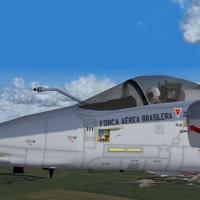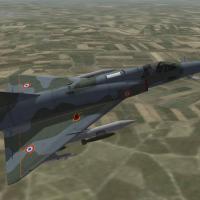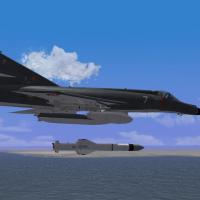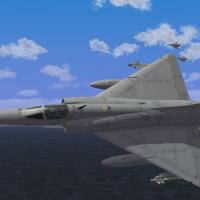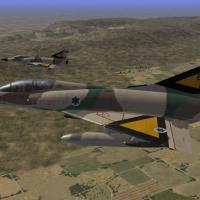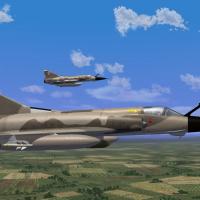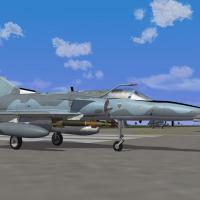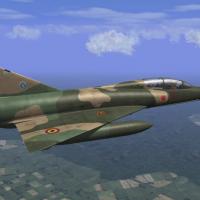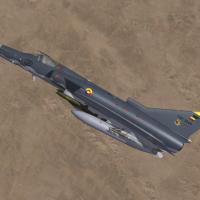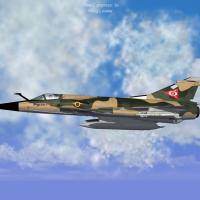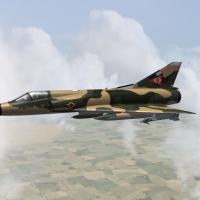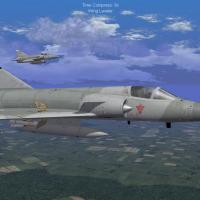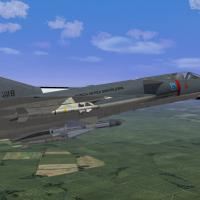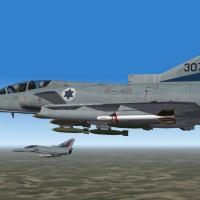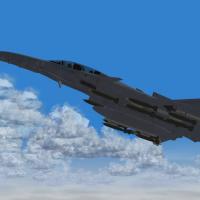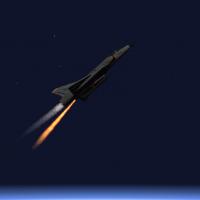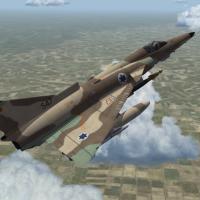-
Content count
583 -
Joined
-
Last visited
-
Days Won
26
Files posted by denissoliveira
-
AMX A-1A, AMX-T A-1B and AMX A-1M Brazilian Air Force
By denissoliveira in Other Origin
The AMX International AMX is a ground-attack aircraft for battlefield interdiction, close air support and reconnaissance missions. It was built until 1999 by AMX International, an Italian-Brazilian joint venture. The AMX is designated A-1 by the Brazilian Air Force, and A-11 Ghibli by the Italian Air Force.
The AMX is capable of operating at high subsonic speed and low altitude, by day or night, and if necessary, from bases with poorly equipped or damaged runways. Low IR signature and reduced radar equivalent cross-section help prevent detection, while low vulnerability of structure and systems aid survivability, while integrated ECM, air-to-air missiles and nose-mounted guns provide self-defence capabilities.
AMX-T
In 1986, development of a two-seat advanced trainer variant was undertaken. This was intended to provide trainee pilots with experience on fast jets, while still retaining the single-seater's attack capabilities. First flying in 1990, the AMX-T equipped both the Italian and Brazilian air forces.
A-1M
The product of a Brazilian upgrade program of their A-1s; significant features include a Mectron SCP-01 Scipio radar, Embraer BR2 data link, FLIR Systems navigation equipment, Elbit INS/GPS/databus, the adoption of a glass cockpit,[31] a new OBOGS system and HMD DASH IV.
O AMX International AMX, ou simplesmente AMX é um avião de ataque ar-superfície usado para missões de interdição, apoio aéreo aproximado e reconhecimento aéreo. Foi desenvolvido pelo consórcio internacional AMX Internacional. Na Força Aérea Brasileira, ele é designado A-1 (A-1A para a versão monoplace e A-1B para a versão de dois lugares). Com a modernização o A-1 passa a incorporar o M em sua designação na FAB, tornando-se então A-1M. Na Itália, ele tem o apelido de "Ghibli".
O AMX é capaz de operar em altas velocidades subsônicas a baixa altitude, tanto de dia quanto de noite, e se necessário, a partir de bases pouco equipadas ou com pistas danificadas. O caça conta com relativamente baixa assinatura em infravermelho e reduzida secção frontal ao radar, para melhorar seu percentual de sucesso nas missões. A auto-defesa é proporcionada por mísseis ar-ar, canhões integrados e sistemas de contramedidas eletrônicas
including:
Two versions of skin
Two fictitious skins (A-1M)
Three models:
AMX-1A
AMX-T A1B
AMX-1M
Model By Rafael Rodrigues
Texture By Denis Oliveira
1,047 downloads
-
Embraer EMB 314 Super Tucano (Beta)
By denissoliveira in Other Origin
The Embraer EMB 314 Super Tucano , also named ALX or A-29, is a Brazilian turboprop light attack aircraftdesigned and built by Embraer as a development of the Embraer EMB 312 Tucano.
He needs a new FM, he is not flying well.
652 downloads
-
Mirage Milan S
By denissoliveira in Other
Mirage Milan S
The latest variant of the basic Mirage III/5 family is the Milan (this name does not refer to the Italian city, but to a bird known in English as the "kite"). It is similar to the Mirage IIIE, but is equipped with retractable fore-planes - these being nicknamed "moustaches". This innovation was developed jointly by Dassault and the Federal Aircraft Factory, of Switzerland, and leads to radically improved take-off and low-speed handling characteristics. Each foreplane has a span of 0.8m and features fixed leading-edge slats and slotted trailing-edge flaps. The whole installation is extremely light and only takes up a small amount of space forward of the cockpit.
Foreplanes were first tested in a fixed installation on a Mirage III during 1968; then followed a retractable installation on a Mirage IIIR, this aircraft being shown at the Paris Air Show in June 1969. Finally, a definitive prototype, known as the Milan S-01, was converted from a Mirage IIIR and first flown on May 29, 1970. The Milan S is powered by a 7,200kg SNECMA 09K-50 and has a greater external load capacity than the Mirage IIIE. It also has improved avionics, including the navigation/attack system developed for the Anglo-French BAC/Breguet Jaguar.
No orders for the Milan had been announced at the time of writing (May 1971) but Dassault has said that deliveries could be started in 1972. Switzerland is being strongly wooed with the type and it is reported that South Africa has been discussing a possible order with the manufacturer.
Requirements: DLC Mirage IIIO
Texture Temp by Ludo.m54
data.ini - Coupi
3D mod - Denis Oliveira
385 downloads
-
Package Étendard
By denissoliveira in Other
Package Étendard
The Dassault-Breguet Super Étendard
The Dassault-Breguet Super Étendard (Étendard is French for "battle flag") is a French carrier-borne strike fighter aircraft designed by Dassault-Breguet for service with the French Navy. The aircraft is an advanced development of the Étendard IVM. The Super Étendard first flew in October 1974 and entered French service in June 1978. French Super Étendards have served in several conflicts such as the Kosovo war, the war in Afghanistan and the military intervention in Libya.
The Super Étendard was also operated by Iraq and Argentina, who both deployed the aircraft during wartime. The Super Étendard was used by Iraq to attack oil tankers and merchant shipping in the Persian Gulf during the Iraq-Iran War. Argentina's use of the Super Étendard and the Exocet missile during the 1982 Falklands War led to the aircraft gaining considerable popular recognition. In French service, the Super Étendard was replaced by the Dassault Rafale in 2016.
Special thanks to Paulopanz and Coupi.
Package includes:
-Etendard IVPM;
-Super Etendard French;
-Super Etendard iraq;
-Super Etendard SEM 1, 2 and 3;
-Super Etendard SEM 4 and 5.
Obs:
(Use crt + = to hide the joystick, and ctr + - to return)
Original 3D model(Étendard) by Bobrock (Giuseppe Valfrè)
Templates Texture by Ludo.m54 & 7eleven
Model(Super Étendard) - DenisOliveira
Texture and Decals - PauloPanz
Data.ini and cockpit.ini - Coupi
Special gratefulness to Coupi, paulopanz.
1,124 downloads
-
Mirage IIIRS
By denissoliveira in Mirage 3
Swiss Mirage IIIRS
Install - Need Update July 2012, DLC Mirage IIIO
In 1961, Switzerland bought a single Mirage IIIC from France. This Mirage IIIC was used as development aircraft. The Swiss Mirages were built in Switzerland by F+W Emmen (today RUAG ) (the federal government aircraft factory in Emmen) as the Mirage IIIS. Australia too, bought, one French-made in preparation for licensed production. Cost overruns during the Swiss production led to the so-called "Mirage affair". In all, 36 Mirage IIIS interceptors were built with strengthened wings, airframe, and undercarriage. The Swiss Air Force required performance comparable to those of carrier based planes; the airframes were reinforced so the aircraft could be moved by lifting them over other aircraft with a crane, as in the Aircraft cavern in the mountains that Swiss Air Force uses as bunkers, offer very little space to maneuver parked aircraft. Also, the strengthened frames allowed for JATO assisted takeoffs. The main differences to the standard Mirage III were as follows:
New wiring of avionics with U.S. electronics
Changed cockpit design with gray instead of black panels
New U.S. radar, TARAN-18 from Hughes
Use of HM-55S "Falcon" (Swiss designation of the from SAAB in Licence built Robot 27 (Rb27) which is similar to the Hughes AIM-26 "Falcon")
Radar warning receiver (RWR) on both wingtips and on the back of the rudder
Strengthened structure for use of JATO-Rockets
Retractable nosecone and lengthened nosewhlle leg for storing in underground air base
Four lifting points for moving aircraft in underground caverns with a crane
Bay at the fin with a SEPR rocket engine to double the velocity for short time or climb to 20 000 m (60 000 ft)
US TRACOR AN/ALE-40 chaff/flare dispenser at the back under the end of the engine (fitted with the upgrade 1988)
Canards designed and produced by RUAG Aerospace(fitted with the upgrade 1988)
New Martin-Baker ejection-seat (fitted with the upgrade 1988)
The Swiss Mirages are equipped with RWS, chaff & flare dispensers. Avionics differed as well, with the most prominent difference being that the Thomson-CSF Cyrano II radar was replaced by Hughes TARAN-18 system, giving the Mirage IIIS compatibility with the Hughes AIM-4 Falcon AAM. Also the Mirage IIIS had the wiring to carry a Swiss-built nuclear bomb or French nuclear bomb. The Swiss nuclear bomb was stopped in the preproduction stage and Switzerland did not purchase the French-made bomb. The Mirage IIIS had an integral fuel tank under the aft belly; this fuel tank could be removed and replaced with an adapter of the same shape. This adapter housed a SEPR rocket engine with its liquid fuel tanks. With the SEPR rocket, the Mirage IIIS easily reached altitudes of 20,000 m. The rocket fuel was very hazardous and highly toxic, so the SEPR rocket was not used very often. The Mirage IIIRS could also carry a photo-reconnaissance centerline pod and an integral fuel tank under the aft belly; this carried a smaller fuel load but allowed a back looking film camera to be added. In the early 1990s, the 30 surviving Swiss Mirage IIIS interceptors were put through an upgrade program, which included fitting them with fixed canards and updated avionics. The Mirage IIIS were phased out of service in 1999. The remaining Mirage IIIRS, BS and DS were taken out of
Special thanks to Paulopanz and Coupi.
Mirage IIIRS
Modelo - TK (Mirage IIIO)
Texture - Ludo, Denis Oliveira
mod - Denis Oliveira
Decals - Paulopanz
Data.ini - Denis Oliveira, Coupi
Cockpit 3D - Denis Oliveira
297 downloads
-
Dassault Étendard IVM/IVP
By denissoliveira in Other
Dassault Étendard IVM/IVP
Etendard IV was like its predecessors a light attack aircraft. In 1956, this unit interests Navy as an embedded multi-role fighter. In December 1956, a semi-navalized prototype is controlled. In May 1957, 5 copies of fully navalized pre-production are controlled by the Navy, which gets its name from Etendard IVM. The first prototype took place May 21, 1958, and the first pre-series will follow on December 21 the same year. Both devices are powered by a SNECMA Atar 08B thrust of 4.4 tonnes. pre-production copies provided with tips of folding wings, the landing gear to be strengthened and the catapult and arrested a drag hook. The second copy of preproduction was pushed by a Rolls-Royce Avon 51 5 tons of thrust, he carried a camera in the nose and was named Etendard IVP (used for tactical reconnaissance). Between 1963 and 1965, 69 Etendard IVM and 21 PVI were delivered to the French air arm, they remained in service until 1991, when they were replaced by the Super-Etendard.
Original 3D model by Bobrock (Giuseppe Valfrè)
Templates by 7eleven & Ludo.m54
Texture and Decals - PauloPanz
Data.ini and cockpit.ini - Coupi
Special gratefulness to Coupi, paulopanz and 7eleven.
Thank Coupi and paulopanz for this and other projects we participate.
770 downloads
-
Dassault-Breguet Super Étendard
By denissoliveira in Other
The Dassault-Breguet Super Étendard
The Dassault-Breguet Super Étendard (Étendard is French for "battle flag") is a French carrier-borne strike fighter aircraft designed by Dassault-Breguet for service with the French Navy. The aircraft is an advanced development of the Étendard IVM. The Super Étendard first flew in October 1974 and entered French service in June 1978. French Super Étendards have served in several conflicts such as the Kosovo war, the war in Afghanistan and the military intervention in Libya.
The Super Étendard was also operated by Iraq and Argentina, who both deployed the aircraft during wartime. The Super Étendard was used by Iraq to attack oil tankers and merchant shipping in the Persian Gulf during the Iraq-Iran War. Argentina's use of the Super Étendard and the Exocet missile during the 1982 Falklands War led to the aircraft gaining considerable popular recognition. In French service, the Super Étendard was replaced by the Dassault Rafale in 2016.
Super Étendard in the Falklands War
The naval aviation, suffering an arms embargo since 1978 by US President Jimmy Carter for human rights abuses, was in the middle of the process of replacing their A-4Q Skyhawks with French-built Dassault-Breguet Super Étendards. Although only five aircraft were delivered by the time of the conflict, the service became famous worldwide when they used their AM39 Exocet anti-shipping missiles, also purchased from France, to sink the Royal Navy's HMS Sheffield and the support ship Atlantic Conveyor. The older A-4Qs also had a role destroying HMS Ardent.
Obs:
(Use crt + = to hide the joystick, and ctr + - to return)
Original 3D model(Étendard) by Bobrock (Giuseppe Valfrè)
Templates Texture by Ludo.m54 & 7eleven
Model(Super Étendard) - DenisOliveira
Texture and Decals - PauloPanz
Data.ini and cockpit.ini - Coupi
Special gratefulness to Coupi, paulopanz and 7eleven.
Thank Coupi and paulopanz for this and other projects we participate.
915 downloads
-
IAI PACK Argentine Air Force
By denissoliveira in Israeli Origin
IAI FINGER A Argentine Air Force (2.0)
Install - Need Update July 2012 and DLC Mirage IIIO
IAI Finger is a jet fighter and bomber Mach 2.2 used by the Air Force Argentina .
Finger is the name of a modernization program carried out at the
planes made ??in Israel IAI Dagger possessed the Argentina Republic .
Modelo - TK (Mirage IIIO)
Texture - Denis Oliveira
Template Texture - Ludo.m54
3D mod - Denis Oliveira
Decals - Denis Oliveira
Modified TW Nesher Cockpit tiles and Avioncs ini - Coupi
Dagger B
The remaining Israeli Nesher aircrafts were refurbished and exported to the Argentine Air Force in two batches, 26 in 1978 and 13 in 1980, under the name Dagger, comprising 35 Dagger A single-seat fighters and 4 Dagger B two-seat trainers.
They formed a new unit, 6th Air Group, and were immediately enlisted with the help of the 8th Air Group (Mirage IIIEA) and the Peruvian Air Force, already a user of the Mirage 5, due to the escalating crisis with Chile of that year.
During the 1982 Falklands War, they were deployed to the southern naval airbase of Río Grande, Tierra del Fuego, and an airfield in Puerto San Julián and despite the distance to their targets and lack of aerial refueling capability, managed to make 153 sorties against both ground and naval targets on the 45 days of operations. In the last role, they damaged HMS Antrim, Brilliant, Broadsword, Ardent, Arrow and Plymouth. Eleven Daggers were lost in combat (nine by AIM-9L Sidewinders fired from Sea Harriers and two by surface to air missiles).
In the 1979 contract with IAI, the Argentine Air Force stipulated that the Daggers would be equipped with new avionics and HUD systems to take them to the Kfir C.2 (and beyond in some subsystems) standard. The program, named Finger, was underway in 1982 when the Falklands War broke out. With the war over, as some of these systems were made by the British Marconi Electronic Systems, they needed to be replaced after an arms embargo was imposed by the UK. The replacement of such systems took the planes to the final Finger IIIB standard mainly by replacing the British equipment with French-built Thomson-CSF.
Texture Temp by Ludo.m54
Texture: PauloPanz
Decals: PauloPanz
Data.ini: Coupi
3D mod: Denis Oliveira
327 downloads
(5 reviews)0 comments
Submitted
-
IAI Nesher T
By denissoliveira in Israeli Origin
IAI Nesher T
The Israel Aircraft Industries Nesher (Hebrew: ?, "Vulture" - often mistranslated as "Eagle") is the Israeli version of the Dassault Mirage 5 multi-role fighter aircraft. Most were later sold to the Argentine Air Force as Daggers, and later upgraded as Fingers.
-Design and development
Israel had to replace more than 60 aircraft lost during the Six Day War and the War of Attrition which followed. Before the war, Israel began co-development with Dassault to build the Mirage 5 and it was eventually built by Israel and named Raam in Hebrew (thunder).
Dassault Aviation had developed the Mirage 5 at the request of the Israelis, who were the main foreign customers of the Mirage III. The Israeli Air Force (IAF) wanted the next version to have less all-weather capability in exchange for improved ordnance carrying capacity and range as the weather in the Middle East is mostly clear.
In January 1969, the French government arms embargo on Israel (in response to the 1968 Israeli raid on Lebanon) prevented the first 30 Mirage 5 aircraft (which were already paid for by Israel) plus optional 20 from being delivered and cut off support for the existing Mirage IIICJ fleet.
This was a setback for the Israeli Air Force, who needed the new Mirage to compensate for the losses of the Six Day War and was still using the Mirage IIIC. Israel then decided to produce the (Raam A and B project) airframes as it had the necessary plans, although Israel did not officially obtain a manufacturing license.
Officially, Israel built the aircraft after obtaining a complete set of drawings. However, some sources claim Israel received 50 Mirage 5s in crates from French Air Force (AdA), while the AdA took over the 50 aircraft originally intended for Israel.
Production began in 1969 with the first empty airframes with no weapons, electronics, seat, or engine included delivered directly from Dassault Aviation. The first Raam A was delivered in May, 1971. In November, 1971 the plane was renamed Nesher.
The Neshers' airframe was identical to the Mirage 5, but there was an extensive refitting of Israeli avionics, a Martin-Baker zero-zero ejection seat, and improved provisions for a wider range of AAMs (Air-to-Air Missiles), including the Israeli Shafrir heat-seeking missile. Fifty-one Nesher fighters (Nesher S) and ten Nesher two-seat trainers (Nesher T) were built in all.
The Nesher had simpler avionics than the Mirage IIIC but was slightly less maneuverable. However, it had longer range and bigger payload. The reduced maneuverability did not prevent the Nesher from performing well in air combat during the Yom Kippur war.
Nesher production was phased out from 1978 to make way for an improved Mirage derivative that had been planned in parallel, in which the Atar engine was replaced by an Israeli-built General Electric J79 engine, the engine used on the American Lockheed F-104 Starfighter and McDonnell Douglas F-4 Phantom II fighters. The result was the IAI Kfir.
-Operational
Israeli Nesher over the Golan Heights during the Yom Kippur War
The first Nesher prototype flew in September 1969, with production deliveries to the IAF beginning in May 1971, ending in February 1974. These aircraft performed well during the 1973 Yom Kippur War, claiming over a hundred kills.
Install: Strike Fighters Israel or Strike Fighters merge.
Texture: TK, Denis Oliveira
Decals: Coupi
Data.ini: Coupi
3D mod: Denis Oliveira
210 downloads
(6 reviews)0 comments
Submitted
-
Mirage 5 Peruvian Air Force
By denissoliveira in Mirage 5
Mirage 5 Package
Need DLC Mirage 5BA.
The Dassault Mirage III is a family of single-seat, single-engine, fighter aircraft produced by Dassault Aviation for the French Air Force and widely exported. Prominent operators included Australia, Argentina, South Africa and Israel, as well as a number of nonaligned nations. Though an older design, the second generation fighter is still a fairly maneuverable aircraft and an effective opponent in close range dogfighting. In French service it was armed with air-to-ground ordnance or R.550 Magic air-to-air missiles.
The versatility of the design enabled production of trainer, reconnaissance and ground-attack versions as well as the Dassault Mirage 5, Dassault Mirage IIIV and Atlas Cheetah variants. A Mirage III was the first European combat aircraft to exceed a speed of Mach 2 in horizontal flight.
Mirage 5DP-4
Mirage 5P-4
exture Temp by Ludo.m54
Texture: Tk,Denis Oliveira, PauloPanz
Decals: Coupi
Data.ini: Coupi
3D mod: Denis Oliveira
UserList and Decals: paulopanz
178 downloads
(4 reviews)0 comments
Submitted
-
Mirage 5 Pack Chile Air Force
By denissoliveira in Mirage 5
Mirage 5 Pack Chile Air Force.
MIRAGE 5MA "ELKAN"
MIRAGE 5MA "ELKAN" (Early)
MIRAGE 5R "ELKAN"
MIRAGE 5MD "ELKAN"
Install - Need DLC7 Mirage5BA.
Mirage 50C [Pantera prototype]
Mirage 50C
Mirage 50CN Pantera
Mirage 50DCN Pantera
Install - Need Update July 2012 and DLC Mirage IIIO
Mirage 50FC
Mirage 50FC (Early)
Install - For Strike fighters 2 Full Merge 4 or 5 (minimum SF2Israel or SF2Europe ).
The Elkan (name of the FACH for Mirage 5 Mirsip) were purchased secondhand from Belgium in 1994 for a total of $ 108 million. Replaced the Hawker Hunter Aviation Group No. 8 based in Antofagasta. During his service with the air force flew more than 14,000 hours over 12 years. The FACH at the time acquired 15 Mirage 5BA MIRSIP (called M-5MA Elkan by FACH), 5 Mirage 5BD MIRSIP (M-5BD Elkan) and 1 and 5 BD Mirage 5 Mirage 5BR reconnaissance without modifying the standard MIRSIP. Aircraft registrations received 701 to 725. At his low eight aircraft were operational, nine out of service and two rugged.
Mirage 50C and 50FC aircraft upgraded by ENAER with help from the Israeli company IAI for Chile with canards, revised, Kfir style nose and new avionics; 13 50C and FC upgraded plus two 50DC trainers.
Later converted mirage50CN Pantera.
Modelo - TK (Mirage IIIO)
Texture - Ludo, Denis Oliveira
mod - Denis Oliveira
Decals - Coupi, PauloPanz
I thank the friends PauloPanz and Coupi.
320 downloads
(6 reviews)0 comments
Submitted
-
Mirage 5BD
By denissoliveira in Mirage 5
Mirage 5BD
The Dassault Mirage III is a family of single-seat, single-engine, fighter aircraft produced by Dassault Aviation for the French Air Force and widely exported. Prominent operators included Australia, Argentina, South Africa and Israel, as well as a number of nonaligned nations. Though an older design, the second generation fighter is still a fairly maneuverable aircraft and an effective opponent in close range dogfighting. In French service it was armed with air-to-ground ordnance or R.550 Magic air-to-air missiles.
The versatility of the design enabled production of trainer, reconnaissance and ground-attack versions as well as the Dassault Mirage 5, Dassault Mirage IIIV and Atlas Cheetah variants. A Mirage III was the first European combat aircraft to exceed a speed of Mach 2 in horizontal flight.
Requirements: DLC Mirage5BA.
Mod by Coupi, Paulo Panz and Denis Oliveira
323 downloads
-
Mirage IIIB/IIIBE PACK
By denissoliveira in Mirage 3
Mirage IIIB/IIIBE PACK
Mirage IIIB
The Armée de l'Air also ordered a two-seat Mirage IIIB operational trainer, which first flew in October 1959. The fuselage was stretched about a meter (3 ft 3.5 in) and both cannons were removed to accommodate the second seat. The IIIB had no radar, and provision for the SEPR rocket was deleted, although it could carry external stores. The AdA ordered 63 Mirage IIIBs (including the prototype), including five Mirage IIIB-1 trials aircraft, ten Mirage IIIB-2(RV) inflight refueling trainers with dummy nose probes, used for training Mirage IVA bomber pilots, and 20 Mirage IIIBEs, with the engine and some other features of the multi-role Mirage IIIE. One Mirage IIIB was fitted with a fly-by-wire flight control system in the mid-1970s and redesignated 'Mirage IIIB-SV (Stabilité Variable); this aircraft was used as a testbed for the system in the later Mirage 2000.
Texture - Coupi
3D mod - Denis Oliveira
Decals - Coupi
Data.ini - Coupi
Cockpit - Coupi
Mirage IIIBE
The Dassault Mirage III is a family of single-seat, single-engine, fighter aircraft produced by Dassault Aviation for the French Air Force and widely exported. Prominent operators included Australia, Argentina, South Africa and Israel, as well as a number of nonaligned nations. Though an older design, the second generation fighter is still a fairly maneuverable aircraft and an effective opponent in close range dogfighting. In French service it was armed with air-to-ground ordnance or R.550 Magic air-to-air missiles.
The versatility of the design enabled production of trainer, reconnaissance and ground-attack versions as well as the Dassault Mirage 5, Dassault Mirage IIIV and Atlas Cheetah variants. A Mirage III was the first European combat aircraft to exceed a speed of Mach 2 in horizontal flight.
Requirements: DLC Mirage IIIO.
Texture Temp by Ludo.m54
Texture: Coupi,Ludo.m54
Decals: Coupi,Denis Oliveira
Data.ini: Coupi,Denis Oliveira
Cockpit: Coupi
3D mod: Denis Oliveira
Pilot: Banidos Team
260 downloads
-
Kfir package
By denissoliveira in Israeli Origin
Kfir package
The Israel Aircraft Industries Kfir (Hebrew: ???????, "Lion Cub") is an Israeli-built all-weather, multirole combat aircraft based on a modified French Dassault Mirage 5 airframe, with Israeli avionics and an Israeli-built version of the General Electric J79 turbojet engine.
Install - For Strike fighters 2 Full Merge 4 or 5.
Kfir C-7 (Israel air force)
Kfir TC-2 (Israel air force)
Kfir C-7 (COLOMBIA air force)
Kfir COA (COLOMBIA air force)
Kfir COD (COLOMBIA air force)
Kfir CE (Ecuator air force)
Kfir TC-2 (Ecuator air force)
Modelo - TK
Texture - TK, Denis Oliveira, Ludo
mod - Denis Oliveira
Data.ini - Coupi, Denis Oliveira
Decals and UserList.ini - paulopanz
F/A-18A Cockpit - Brain32
Kfir Cockpit - Mirage Factory
632 downloads
-
Mirage 5/50 Venezuela Pack
By denissoliveira in Mirage 5
Mirage 5V/5DV Venezuela Air Force
Mirage 5EV Venezuelan Air Force, Later upgraded to Mirage 50EV.
Texture - Ludo, TK, Denis Oliveira
mod - Denis Oliveira
Decals and UserList.ini - paulopanz
Mirage 50EV/50DV Venezuela Air Force
Install - Need Update July 2012 and DLC Mirage IIIO
Upgraded Mirage 5V aircraft for Venezuela, with Atar 9K-50 engine, canards and updated avionics (including radar).Six new-build aircraft, three upgraded ex-Zaire 5M, plus six upgraded remaining IIIEV and 5Vs.
Modelo - TK (Mirage IIIO)
Texture - TK, Denis Oliveira, Ludo
mod - Denis Oliveira
Data.ini - Coupi, Denis Oliveira
Decals and UserList.ini - paulopanz
259 downloads
-
Mirage IIIEV Venezuela Air Force
By denissoliveira in Mirage 3
Mirage IIIEV Venezuela Air Force
Install - Need Update July 2012 and DLC Mirage IIIO
Mirage IIIEV Venezuelan Air Force, Later upgraded to Mirage 50EV.
Open Cockpit - shft +1
Model - TK (Mirage IIIO)
Texture - Ludo, TK, Denis Oliveira
mod - Denis Oliveira
Decals and UserList.ini - paulopanz
Thank paulopanz and coupi for the great help!
223 downloads
(2 reviews)0 comments
Updated
-
Swiss Mirage III Pack
By denissoliveira in Mirage 3
Swiss Mirage III Pack
Install - Need Update July 2012, DLC Mirage IIIO
In 1961, Switzerland bought a single Mirage IIIC from France. This Mirage IIIC was used as development aircraft. The Swiss Mirages were built in Switzerland by F+W Emmen (today RUAG ) (the federal government aircraft factory in Emmen) as the Mirage IIIS. Australia too, bought, one French-made in preparation for licensed production. Cost overruns during the Swiss production led to the so-called "Mirage affair". In all, 36 Mirage IIIS interceptors were built with strengthened wings, airframe, and undercarriage. The Swiss Air Force required performance comparable to those of carrier based planes; the airframes were reinforced so the aircraft could be moved by lifting them over other aircraft with a crane, as in the Aircraft cavern in the mountains that Swiss Air Force uses as bunkers, offer very little space to maneuver parked aircraft. Also, the strengthened frames allowed for JATO assisted takeoffs. The main differences to the standard Mirage III were as follows:
New wiring of avionics with U.S. electronics
Changed cockpit design with gray instead of black panels
New U.S. radar, TARAN-18 from Hughes
Use of HM-55S "Falcon" (Swiss designation of the from SAAB in Licence built Robot 27 (Rb27) which is similar to the Hughes AIM-26 "Falcon")
Radar warning receiver (RWR) on both wingtips and on the back of the rudder
Strengthened structure for use of JATO-Rockets
Retractable nosecone and lengthened nosewhlle leg for storing in underground air base
Four lifting points for moving aircraft in underground caverns with a crane
Bay at the fin with a SEPR rocket engine to double the velocity for short time or climb to 20 000 m (60 000 ft)
US TRACOR AN/ALE-40 chaff/flare dispenser at the back under the end of the engine (fitted with the upgrade 1988)
Canards designed and produced by RUAG Aerospace(fitted with the upgrade 1988)
New Martin-Baker ejection-seat (fitted with the upgrade 1988)
The Swiss Mirages are equipped with RWS, chaff & flare dispensers. Avionics differed as well, with the most prominent difference being that the Thomson-CSF Cyrano II radar was replaced by Hughes TARAN-18 system, giving the Mirage IIIS compatibility with the Hughes AIM-4 Falcon AAM. Also the Mirage IIIS had the wiring to carry a Swiss-built nuclear bomb or French nuclear bomb. The Swiss nuclear bomb was stopped in the preproduction stage and Switzerland did not purchase the French-made bomb. The Mirage IIIS had an integral fuel tank under the aft belly; this fuel tank could be removed and replaced with an adapter of the same shape. This adapter housed a SEPR rocket engine with its liquid fuel tanks. With the SEPR rocket, the Mirage IIIS easily reached altitudes of 20,000 m. The rocket fuel was very hazardous and highly toxic, so the SEPR rocket was not used very often. The Mirage IIIRS could also carry a photo-reconnaissance centerline pod and an integral fuel tank under the aft belly; this carried a smaller fuel load but allowed a back looking film camera to be added. In the early 1990s, the 30 surviving Swiss Mirage IIIS interceptors were put through an upgrade program, which included fitting them with fixed canards and updated avionics. The Mirage IIIS were phased out of service in 1999. The remaining Mirage IIIRS, BS and DS were taken out of
Special thanks to Paulopanz and Coupi.
Mirage IIIBS
Mirage IIIS (Early)
Mirage IIIS
Mirage IIIDS
Mirage IIIRS (Early)
Mirage IIIRS
Modelo - TK (Mirage IIIO)
Texture - Ludo, Denis Oliveira
mod - Denis Oliveira
Decals - Paulopanz
Data.ini - Denis Oliveira, Coupi
Cockpit and Avioncs ini - Coupi, Denis Oliveira
327 downloads
-
Mirage IIIBL
By denissoliveira in Mirage 3
Mirage IIIBL Libanon.
Requirements: DLC Mirage IIIEL
https://store.thirdwire.com/store_dlc.htm
credits:
paulopanz
Coupi
188 downloads
-
F-103E and F-103D - Mirage III Brazilian Air Force PACK
By denissoliveira in Mirage 3
F-103 Mirage III Brazilian Air Force
Install - Need Update July 2012, DLC Mirage IIIO (DLC Mirage IIIEL optional cockpit)
History
The history of the Mirage III in Brazil goes back to the sixties, when the FAB elaborated a modernization program and the creation of an air space control system. In 1967 the implementation started of the SISDACTA- Sistema Integrado de Defesa Aérea e Controle de Tráfego Aéreo (Integrated Air Traffic Control and Air Defence System) and of the COMDA-Comando de Defesa Aérea (Air Defence Command).
As part of the program, it was necessary to acquire a supersonic aircraft to execute the air defence and interception missions. The FAB's initial desire was to obtain the McDonnell Douglas F-4 Phantom II, however it could not be materialised because of American restrictions on the sale of advanced military equipment to South American countries.
With the Phantom out of the game, the remaining option was to look for an European fighter. Among the contenders were the British English Electric Lightning, the Swedish Saab Draken and the French Dassault-Breguet Mirage IIIE. About the same time, the Mirage IIIC, in the hands of the Israeli pilots, inflicted heavy losses to its Arabic neighbours in the 'Six Day War'. There is no doubt that the Mirage III's excellent performance, achieved by the Israelis in that war, helped Dassault-Breguet secure many clients around the world, including Brazil.
Operational Career
On April 11, 1979, the 1º GDA ( Primeiro Grupo de Defesa Aérea – First Air Defence Group) was officially established. On April 19, 1979, the 1º ALADA was disbanded and the 1º GDA took over its functions and F-103 aircraft. The 1º GDA remained stationed at Anápolis AB.
During its operational career in Brazil, the Mirage III fleet suffered some attrition and many additional airframes were bought to replace the lost ones and to keep up the 1º GDA's combat readiness. In total, Brazil acquired 16 additional aircraft from Armée de L’Air surplus. These consisted of four F-103E in 1980, two F-103D in 1984, two F-103E in 1988, two F-103D and two F-103E in 1989, two F-103E in 1998 and the last two F-103D in 1999.
The F-103 Mirage IIIEBR represented a tremendous leap to the Brazilian Air Force, being over thirty years of service and more than 65,000 flying hours.
The versions of Mirage III acquired by FAB were developed primarily for air defense missions, but keep some capacity to act as platforms for ground attack.
The engine was a SNECMA ATAR 09C, whose maximum thrust with afterburning reached 13,900 pounds (6305 kg), leading the aircraft a maximum speed of Mach 2.2 (2,350 km / h).
The fire control system was based on radar Thomson-CSF Cyrano II, which originally operated the integrated air-to-air missile infrared Matra R530, later replaced by Israeli missile Python III.
As arms fixed, the aircraft was equipped with two 30 mm DEFA. For navigation, the Mirage III FAB type Doppler systems used. In the early '90s, the FAB joined the Squadron's missions Jaguar air-ground attack, starting to use free-fall bombs and rocket launchers.
(Portuguese)
História
A história do Mirage III no Brasil remonta à década de sessenta, quando a FAB elaborou um programa de modernização e criação de um sistema de controle do espaço aéreo. Em 1967, a implementação começou da SISDACTA- Sistema Integrado de Defesa Aérea e Controle de Tráfego Aéreo (Air Traffic Control Integrado e Air Sistema de Defesa) e do COMDA-Comando de Defesa Aérea (Comando de Defesa Aérea).
Como parte do programa, foi necessário adquirir um avião supersônico para executar as missões de defesa aérea e interceptação. Desejo inicial da FAB foi obter a McDonnell Douglas F-4 Phantom II, no entanto, ele não poderia ser materializado por causa das restrições americanas sobre a venda de equipamento militar avançado para os países da América do Sul.
Com o Fantasma fora do jogo, a opção restante era procurar um lutador europeu. Entre os contendores foram o Inglês Britânico elétrico do relâmpago, a sueca Saab Draken e os franceses Dassault-Breguet Mirage IIIE. Quase ao mesmo tempo, o Mirage IIIC, nas mãos dos pilotos israelenses, infligiu pesadas perdas para os seus vizinhos árabes na 'Guerra dos Seis Dias ". Não há dúvida de que o excelente desempenho do Mirage III, alcançada pelos israelenses em que a guerra, ajudou a Dassault-Breguet garantir muitos clientes ao redor do mundo, incluindo o Brasil.
Carreira Operacional
Em 11 de abril de 1979, o 1º GDA (Primeiro Grupo de Defesa Aérea - First Air Grupo de Defesa) foi criada oficialmente. Em 19 de abril de 1979 a 1º ALADA foi dissolvida e o 1º GDA assumiu suas funções e aeronaves F-103. O 1º GDA permaneceu estacionada em Anápolis AB.
Durante a sua carreira operacional no Brasil, a frota de Mirage III sofrido algum desgaste e muitas fuselagens adicionais foram comprados para substituir os perdidos e para manter a prontidão de combate do 1º GDA. No total, o Brasil adquiriu 16 aeronaves adicionais a partir do excedente Armée de L'Air. Estes consistiram de quatro F-103E, em 1980, dois F-103D em 1984, dois F-103E, em 1988, dois F-103D e dois F-103E, em 1989, dois F-103E em 1998 e os dois últimos F-103D em de 1999.
O F-103 Mirage IIIEBR representou um tremendo salto para a Força Aérea Brasileira, ficando mais de trinta anos de serviço e voando mais de 65.000 horas.
Os Mirage III das versões adquiridas pela FAB foram desenvolvidas primariamente para missões de defesa aérea, embora mantivessem alguma capacidade de atuar como plataformas de ataque ao solo.
O motor era um SNECMA ATAR 09C, cujo empuxo máximo com pós-combustão alcançava 13.900 libras (6.305 kg), levando a aeronave a velocidade máxima de Mach 2,2 (2.350 km/h).
O sistema de controle de fogo era baseado no radar Thomson-CSF Cyrano II, que originalmente operava integrado ao míssil ar-ar infra-vermelho Matra R530, depois substituído pelo míssil israelense Python III.
Como armamento fixo, a aeronave era dotada de dois canhões DEFA de 30 mm. Para navegação, os Mirage III da FAB utilizavam sistemas tipo Doppler. No inícios dos anos 90, a FAB incorporou ao Esquadrão Jaguar as missões de ataque ar-solo, passando a utilizar bombas de queda livre e lançadores de foguetes.
Special thanks to Paulopanz and Coupi.
Mirage IIIEBR (3 textures and 1 silver texture)
Mirage IIIEBR (fictitious - fuel probe test in 1990-93)
Mirage IIIDRB (late and Early)
Modelo - TK (Mirage IIIO)
Texture - Ludo, Denis Oliveira
mod - Denis Oliveira
Decals - Paulopanz
Data.ini - Denis Oliveira, Coupi
323 downloads
-
Atlas Cheetah C Ecuador Air Force
By denissoliveira in Other Origin
Atlas Cheetah C Ecuador Air Force
Install - Need Update July 2012 and DLC Mirage IIIO
The Cheetah C was the ultimate development of the Cheetah series, and was the only fighter aircraft in service with the SAAF until replaced by the Saab JAS 39 Gripen in 2008. Many of the features of the Cheetah aircraft are still classified, and the SAAF is unwilling to reveal too many details. What is known is that in addition to the upgrades described above, the Cheetah C incorporates a more sophisticated avionics and navigation suite and a new pulse-doppler multi-mode radar (ELTA), both of which are regarded as being better than the systems fitted to Block 50 F-16s[citation needed], and one of the most advanced EW systems fitted to a fighter aircraft. The aircraft is also fitted with a data link, though the capabilities of this system are unknown, and it received updated versions of the helmet-mounted sight, HUD and improved HOTAS controls.
Other improvements include the fitting of a single-piece wrap-around windshield with an anti-radiation coating in place of the old three-piece version, a new in-flight refuelling probe with less external piping, new undercarriage and suspension, the deletion of the wing fences, an upgraded version of the Atar 9K50 and a new nose to incorporate the more sophisticated electronics and radar.
Like the Cheetah D, the Cheetah C is capable of delivering precision-guided munitions (PGMs), ranging from laser-guided bombs (LGBs), to GPS-guided weapons and TV-guided bombs. It also has the capability of using stand-off air-to-ground weapons such as the MUPSOW and TORGOS. In addition, it is able to carry a raft of air-to-air weapons, and the SAAF currently equips its aircraft with the V4 R-Darter, a beyond-visual-range (BVR) radar-guided missile, and the U-Darter, a highly capable short-range infrared (IR)-guided missile.
A measure of the capabilities of the Cheetah C is the result of an air-combat maneuvering (ACM) exercise between the Cheetah Cs of 2 Squadron and F-15E Strike Eagles of the 494th Fighter Squadron, United States Air Force at RAF Lakenheath, after which the score tallies for each side were almost exactly equal.
Now sold to the Equator.
Animed Cockpit - SHFT + 1
Modelo - TK (Mirage IIIO)
Texture - Denis Oliveira
Template Texture - Ludo
3D mod - Denis Oliveira
Decals - Denis Oliveira
Data ini - Coupi, Denis Oliveira
Cockpit and Avioncs ini - Coupi, MirageFactory
312 downloads
(5 reviews)0 comments
Updated
-
Atlas Cheetah C south african Air Force
By denissoliveira in Other Origin
Atlas Cheetah C south african Air Force
Install - Need Update July 2012 and DLC Mirage IIIO
The Cheetah C was the ultimate development of the Cheetah series, and was the only fighter aircraft in service with the SAAF until replaced by the Saab JAS 39 Gripen in 2008. Many of the features of the Cheetah aircraft are still classified, and the SAAF is unwilling to reveal too many details. What is known is that in addition to the upgrades described above, the Cheetah C incorporates a more sophisticated avionics and navigation suite and a new pulse-doppler multi-mode radar (ELTA), both of which are regarded as being better than the systems fitted to Block 50 F-16s[citation needed], and one of the most advanced EW systems fitted to a fighter aircraft. The aircraft is also fitted with a data link, though the capabilities of this system are unknown, and it received updated versions of the helmet-mounted sight, HUD and improved HOTAS controls.
Other improvements include the fitting of a single-piece wrap-around windshield with an anti-radiation coating in place of the old three-piece version, a new in-flight refuelling probe with less external piping, new undercarriage and suspension, the deletion of the wing fences, an upgraded version of the Atar 9K50 and a new nose to incorporate the more sophisticated electronics and radar.
Like the Cheetah D, the Cheetah C is capable of delivering precision-guided munitions (PGMs), ranging from laser-guided bombs (LGBs), to GPS-guided weapons and TV-guided bombs. It also has the capability of using stand-off air-to-ground weapons such as the MUPSOW and TORGOS. In addition, it is able to carry a raft of air-to-air weapons, and the SAAF currently equips its aircraft with the V4 R-Darter, a beyond-visual-range (BVR) radar-guided missile, and the U-Darter, a highly capable short-range infrared (IR)-guided missile.
A measure of the capabilities of the Cheetah C is the result of an air-combat maneuvering (ACM) exercise between the Cheetah Cs of 2 Squadron and F-15E Strike Eagles of the 494th Fighter Squadron, United States Air Force at RAF Lakenheath, after which the score tallies for each side were almost exactly equal.
Animed Cockpit - SHFT + 1
Modelo - TK (Mirage IIIO)
Texture - Denis Oliveira
Template Texture - Ludo
3D mod - Denis Oliveira
Decals - Denis Oliveira
Data ini - Coupi, Denis Oliveira
Cockpit and Avioncs ini - Coupi, MirageFactory
501 downloads
(4 reviews)0 comments
Updated
-
Kfir TC-2
By denissoliveira in Israeli Origin
Kfir TC-2
The Israel Aircraft Industries Kfir (Hebrew: ?, "Lion Cub") is an Israeli-built all-weather, multirole combat aircraft based on a modified French Dassault Mirage 5 airframe, with Israeli avionics and an Israeli-made version of the General Electric J79 turbojet engine.
Texture: TK, Denis Oliveira
Decals: Coupi
Data.ini: Coupi
3D mod: Denis Oliveira
379 downloads
-
Kfir TC-2 FAE
By denissoliveira in Israeli Origin
Kfir TC-2 FAE
The Israel Aircraft Industries Kfir (Hebrew: ?, "Lion Cub") is an Israeli-built all-weather, multirole combat aircraft based on a modified French Dassault Mirage 5 airframe, with Israeli avionics and an Israeli-made version of the General Electric J79 turbojet engine.
Texture: TK, Denis Oliveira
Cockpit: Denis Oliveira
3D mod: Denis Oliveira
191 downloads
(2 reviews)0 comments
Updated
-
Mirage IIIC (SEPR)
By denissoliveira in Mirage 3
Mirage IIIC (SEPR)
The new fighter design was named the Mirage III. It incorporated the new area ruling concept, where changes to the cross section of an aircraft were made as gradual as possible, resulting in the famous "wasp waist" configuration of many supersonic fighters. Like the Mirage I, the Mirage III had provision for a SEPR rocket engine.
The prototype Mirage III flew on 17 November 1956, and attained a speed of Mach 1.52 on its 10th flight. The prototype was then fitted with manually operated intake half-cone shock diffusers, known as souris ("mice"), which were moved forward as speed increased to reduce inlet turbulence. The Mirage III attained a speed of Mach 1.8 in September 1957.
The success of the Mirage III prototype resulted in an order for 10 pre-production Mirage IIIA fighters. These were almost two meters longer than the Mirage III prototype, had a wing with 17.3% more area, a chord reduced to 4.5%, and an Atar 09B turbojet with afterburning thrust of 58.9 kN (13,230 lbf). The SEPR rocket engine was retained, and the aircraft were fitted with Thomson-CSF Cyrano Ibis air intercept radar, operational avionics, and a drag chute to shorten landing roll
Texture Temp by Ludo.m54
Texture and Data.INI: Coupi
3D mod: Denis Oliveira
251 downloads
-
Kfir C7
By denissoliveira in Israeli Origin
Kfir C7
The Israel Aircraft Industries Kfir (Hebrew: ???????,, "Lion Cub") is an Israeli-built all-weather, multirole combat aircraft based on a modified French Dassault Mirage 5 airframe, with Israeli avionics and an Israeli-built version of the General Electric J79 turbojet engine.
The Kfir C.7 Vastly modified variant. Most if not all C.2 aircraft were modified to this variant. It included an improved J79-GEJ1E engine that offered more 1,000 lbs of thrust at full afterburner (and as a result increasing the Maximum Take-off Weight by 3,395 lbs), 2 more hardpoints under the air intakes, better avionics such as the Elta EL/M-2021B radar, HOTAS configured cockpit and inflight refueling capability.
Texture and Data.INI: Coupi
3D mod: Denis Oliveira
Original Panel: MirageFactory
Original Texture: TK
437 downloads


